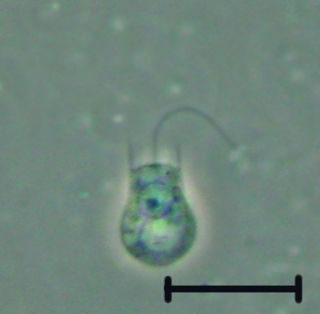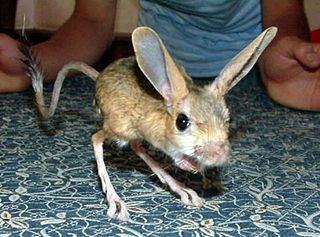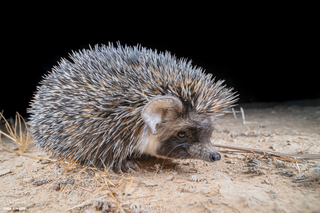
The choanoflagellates are a group of free-living unicellular and colonial flagellate eukaryotes considered to be the closest living relatives of the animals. Choanoflagellates are collared flagellates, having a funnel shaped collar of interconnected microvilli at the base of a flagellum. Choanoflagellates are capable of both asexual and sexual reproduction. They have a distinctive cell morphology characterized by an ovoid or spherical cell body 3–10 µm in diameter with a single apical flagellum surrounded by a collar of 30–40 microvilli. Movement of the flagellum creates water currents that can propel free-swimming choanoflagellates through the water column and trap bacteria and detritus against the collar of microvilli, where these foodstuffs are engulfed. This feeding provides a critical link within the global carbon cycle, linking trophic levels. In addition to their critical ecological roles, choanoflagellates are of particular interest to evolutionary biologists studying the origins of multicellularity in animals. As the closest living relatives of animals, choanoflagellates serve as a useful model for reconstructions of the last unicellular ancestor of animals.
Cystophora is a genus of brown algae found mostly in temperate waters around Australia. Most of the southern Australian species can be immediately recognised as belonging to this genus by their characteristic zigzag branching pattern. Identification of individual species is generally more difficult and relies on the size and shape of branches, particularly terminal branches, which are specialised reproductive structures known as receptacles. Due to their local diversity and dominance in southern Australia, they are regarded by some as 'the eucalypts of the underwater world'.

The four-toed jerboa is a rodent of the family Dipodidae and genus Scarturus that has four digits. Four-toed jerboas are native to Egypt and Libya. They live in coastal salt marshes and dry deserts.

The hairy-tailed bolo mouse or hairy-tailed akodont is a South American rodent species of the family Cricetidae. It is found in Argentina, Bolivia, Brazil, and Paraguay.
Huntiella moniliformis is a saprobic fungal species that was previously accommodated in the Ceratocystis genus. Due to morphological, molecular and ecological differences, it was recently allocated to the newly described Huntiella genus. Species belonging to this genus typically do not cause disease on plants with the exception of H. bhutanensis. These species are almost always found on freshly cut timber or wounded trees.

The North African hedgehog or Algerian hedgehog, is a mammal species in the family Erinaceidae native to Algeria, Libya, Malta, Morocco, Spain, and Tunisia. Little is known about this hedgehog, even though the most common breed of domesticated hedgehogs is a result of crossing a four-toed hedgehog with a North African hedgehog. Because this species of hedgehog is native to Africa, it has been suggested that it was introduced by humans to the other countries where it is now found, including Spain and the Canary Islands. Of the four African hedgehog species, the North African hedgehog is the only one of these hedgehogs that occurs outside Africa. Because the North African hedgehog has such a wide habitat range and has a seemingly stable population, both in the wild and in the domesticated capacity, it does not appear to currently be at risk.

The desert hedgehog is a species of mammal in the family Erinaceidae.

Moniliformidae is a family of parasitic spiny-headed worms. It is the only family in the Moniliformida order and contains three genera: Australiformis containing a single species, Moniliformis containing eighteen species and Promoniliformis containing a single species. Genetic analysis have determined that the clade is monophyletic despite being distributed globally. These worms primarily parasitize mammals, including humans in the case of Moniliformis moniliformis, and occasionally birds by attaching themselves into the intestinal wall using their hook-covered proboscis. The intermediate hosts are mostly cockroaches. The distinguishing features of this order among archiacanthocephalans is the presence of a cylindrical proboscis with long rows of hooks with posteriorly directed roots and proboscis retractor muscles that pierce both the posterior and ventral end or just posterior end of the receptacle. Infestation with Monoliformida species can cause moniliformiasis, an intestinal condition characterized as causing lesions, intestinal distension, perforated ulcers, enteritis, gastritis, crypt hypertrophy, goblet cell hyperplasia, and blockages.

Moniliformis moniliformis is a parasite of the Acanthocephala phylum in the family Moniliformidae. The adult worms are usually found in intestines of rodents or carnivores such as cats and dogs. The species can also infest humans, though this is rare.

Lunella is a genus of sea snails, marine gastropod mollusks in the family Turbinidae, the turban snails.

Neritopsis is a genus of sea snails in the subfamily Neritopsinae of the family Neritopsidae.

Streptobacillus moniliformis is a non-motile, Gram-negative rod-shaped bacterium that is a member of the family Leptotrichiaceae. The genome of S. moniliformis is one of two completed sequences of the order Fusobacteriales.
Koloonella is a genus of sea snails, marine gastropod mollusks in the family Murchisonellidae, the pyrams and their allies.
Koloonella moniliformis, common name the necklace pyramid-shell, is a species of sea snail, a marine gastropod mollusk in the family Murchisonellidae, the pyrams and their allies.
Lunella moniliformis is a species of sea snail, a marine gastropod mollusk in the family Turbinidae, the turban snails.
Moncrieff Bay is a bay in the Australian state of South Australia located at the east end of the Dudley Peninsula on Kangaroo Island in the gazetted locality of Willoughby overlooking Backstairs Passage about 106 kilometres (66 mi) south-west of the state capital of Adelaide and about 47 kilometres (29 mi) south-east of the municipal seat of Kingscote.
Codonosigaceae is a family of choanoflagellates.
Nicholsonella is an extinct genus of bryozoans of uncertain taxonomic placement. Its colonies can take the forms of thick branching masses or branches.

Myrmecopterula is a genus of fungi in the family Pterulaceae. Basidiocarps are clavarioid and are associated with ant domestication by members of the genus Apterostigma.

Myrmecopterula moniliformis is a species of fungus in the family Pterulaceae and is the type species of the genus Myrmecopterula. It is associated with fungi cultivating ants of the genus Apterostigma.










